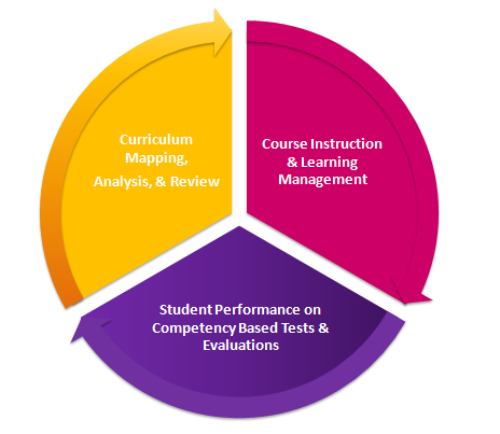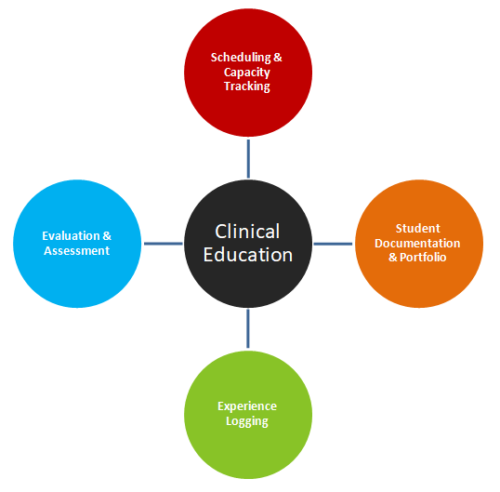Education?
As the Competency Based Veterinary Education Framework becomes the standard in Veterinary Medicine Schools, institutions will need specialized systems to track the teaching and learning of the nine domains of competence and the more granular sub-competencies.
Meet Technology.
eMedley for Veterinary Medicine provides a comprehensive solution for schools to map course and rotation objectives to competencies, assess student learning, and track EPA’s and milestones. It covers both pre-clinical and clinical education.
Features
Pre-Clinical
Clinical
Curriculum Mapping
Map curriculum to domains of competence, EPA’s, and outcomes to identify gaps and overlaps in instruction and to build a competency framework.
Affiliation Management
Track affiliation agreements and required documentation with externship sites and get automatic reminders when those agreements expire.
Learning Management
Manage communication with students, assignments, gradebooks, attendance, discussions, and assessments.
Compliance and Documentation
Track documentation for faculty and preceptor credentialing, licensing, student documentation, regulation, and certification expiration dates and renewals with automatic reminders.
Testing and Assessment
Test with a secure lockdown browser, online and off-line testing, data dashboard, and item bank management.
Scheduling
Plan schedules with preference-based planning, lottery-based scheduling, optimization scheduling, track and path scheduling, internal and external rotation scheduling, capacity management and tracking with the Schedule Planner.
Course and Faculty Evaluations
Administer course and faculty evaluations based on student and course schedules to evaluate program effectiveness.
Time and Case Logging
Students can log cases, track time logs, and make portfolios with curriculum integration, while administrators track competencies, view data dashboards, and review ad-hoc reporting.
Preloaded Standards
Pre-load AVMA Core Competencies, CBVE Framework, EPAs, disciplines, domains, and milestones for mapping curriculum and assessments.
Evaluations
Create formative and summative evaluations, competency based evaluations, OSCE’s, clinical site and preceptor evaluations, student performance evaluations, self-evaluations, and automated reminders.
Course Syllabus Generation
Pull curriculum elements into the course syllabus and ensure that all course syllabuses have a consistent format and include required components.
Process
Pre-Clinical

Clinical

Pre-Clinical

Step 1
Map Curriculum: Map where, when and how students are learning Course Objectives, Session Objectives, and Competencies.
Step 2
Schedule Course Events: Schedule academic sessions in the course calendar to track hours allocated to specific topics and types of instruction.
Step 3
Manage Course Instruction: Manage classroom instruction by posting announcements, assignments, tests, and grades for students to see in eduCATE.
Step 4
Assess and Evaluate Progress: Students complete tests, performance based assessments, and evaluations.
Step 5
Analyze Performance Data: Review results from assessments and evaluations to find learning gaps and enhance curricula and instruction.
Clinical

Step 1
Set Schedule Parameters: Define clinical schedule format, rules, and requirements by student cohort or academic year.
Step 2
Run Automated Scheduler: Schedule students into clinical rotations based on rules and requirements using an optimized automated scheduler.
Step 3
Track Regulatory Requirements: Ensure that students, sites, and preceptors have all required affiliation agreements, certifications, and other documentation in place.
Step 4
Track Student Experience: Track the amount and quality of student experience through case logging, skill tracking, and time logging.
Step 5
Assess and Evaluate: Administer schedule and competency based clinical evaluations for students, preceptors, and sites.
Step 1
Map Curriculum: Map where, when and how students are learning Course Objectives, Session Objectives, and Competencies.
Step 1
Set Schedule Parameters: Define clinical schedule format, rules, and requirements by student cohort or academic year.
Step 2
Schedule Course Events: Schedule academic sessions in the course calendar to track hours allocated to specific topics and types of instruction.
Step 2
Run Automated Scheduler: Schedule students into clinical rotations based on rules and requirements using an optimized automated scheduler.
Step 3
Manage Course Instruction: Manage classroom instruction by posting announcements, assignments, tests, and grades for students to see in eduCATE.
Step 3
Track Regulatory Requirements: Ensure that students, sites, and preceptors have all required affiliation agreements, certifications, and other documentation in place.
Step 4
Assess and Evaluate Progress: Students complete tests, performance based assessments, and evaluations.
Step 4
Track Student Experience: Track the amount and quality of student experience through case logging, skill tracking, and time logging.
Step 5
Analyze Performance Data: Review results from assessments and evaluations to find learning gaps and enhance curricula and instruction.
Step 5
Assess and Evaluate: Administer schedule and competency based clinical evaluations for students, preceptors, and sites.